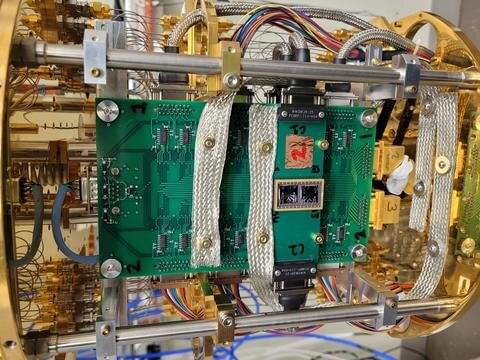By understanding your body language, Google wants its products to offer you just what you want, just when you need it.



Our new US2QC program aims to determine if an underexplored approach to quantum computing is capable of achieving operation much faster than conventional predictions. https://ow.ly/ABgY50I1qEq
High-fidelity touch has the potential to significantly expand the scope of what we expect from computing devices, making new remote sensory experiences possible. The research on these advancements, led by a pair of researchers from the J. Mike Walker Department of Mechanical Engineering at Texas A&M University, could help touchscreens simulate virtual shapes.
Dr. Cynthia Hipwell is studying friction at the finger-device level, while Dr. Jonathan Felts is researching friction in the interaction between single skin cells and the glass of the touchscreen interface. The two are bringing together their respective areas of expertise to apply friction principles at the microscopic level to finger-device interaction mechanics.
Hipwell highlighted the significance of the pursuit by comparing it to the technologies currently available for conveying immersive and accurate information through high-fidelity audio and video.

A study published in Frontiers in Computational Neuroscience has revealed that the human brain’s structures operate in up to 11 dimensions.
The dimensions are not understood as the classic definition of a dimension, which most of us understand, the Blue Brain Project explains.
Conducted by the Blue Brain Project, scientists discovered fascinating new details about the human brain’s complexity.

A huge amount of mysterious dark energy is necessary to explain cosmological phenomena, such as the accelerated expansion of the Universe, using Einstein’s theory. But what if dark energy was just an illusion and general relativity itself had to be modified? A new SISSA study, published in Physical Review Letters, offers a new approach to answer this question. Thanks to huge computational and mathematical effort, scientists produced the first simulation ever of merging binary neutron stars in theories beyond general relativity that reproduce a dark-energy like behavior on cosmological scales. This allows the comparison of Einstein’s theory and modified versions of it, and, with sufficiently accurate data, may solve the dark energy mystery.
For about 100 years now, general relativity has been very successful at describing gravity on a variety of regimes, passing all experimental tests on Earth and the solar system. However, to explain cosmological observations such as the observed accelerated expansion of the Universe, we need to introduce dark components, such as dark matter and dark energy, which still remain a mystery.
Enrico Barausse, astrophysicist at SISSA (Scuola Internazionale Superiore di Studi Avanzati) and principal investigator of the ERC grant GRAMS (GRavity from Astrophysical to Microscopic Scales) questions whether dark energy is real or, instead, it may be interpreted as a breakdown of our understanding of gravity. “The existence of dark energy could be just an illusion,” he says, “the accelerated expansion of the Universe might be caused by some yet unknown modifications of general relativity, a sort of ‘dark gravity’.”

Elon Musk has a knack for accomplishing feats that others consider improbable. From blasting rockets into space to becoming the king of the EV industry, Musk is determined to make history.
His latest passion project is Neuralink—a company that is developing a brain implant that will link the human brain directly to computers. He claims this brain-computer interface (BCI) will enable humans to carry out actions through thought alone. One of Musk’s first goals: helping paraplegics regain their independence.
But it doesn’t stop there. The company’s technology, Musk hopes, will one day not only treat but cure brain disorders and even save memories so people can revisit them like photo albums.

Researchers at the National Institute of Standards and Technology (NIST) have constructed and tested a system that allows commercial electronic components—such as microprocessors on circuit boards—to operate in close proximity with ultra-cold devices employed in quantum information processing. That design allows four times as much data to be output for the same number of connected wires.
In the rising excitement about quantum computing, it can be easy to overlook the physical fact that the data produced by manipulation of quantum bits (qubits) at cryogenic temperatures a few thousandths of a degree above absolute zero still has to be initiated, read out, and stored using conventional electronics, which presently work only at room temperature, several meters away from the qubits. This separation has obstructed development of quantum computing devices that outperform their classical counterparts.
That extra distance between the quantum computing elements and the external electronics requires extra time for signals to travel, which also causes signals to degrade. In addition, each (comparatively very hot) wire needed to connect the electronics to the cryogenic components adds heat, making it hard to maintain the ultracold temperature required for the quantum devices to work.

Homomorphic encryption is considered a next generation data security technology, but researchers have identified a vulnerability that allows them to steal data even as it is being encrypted.
“We weren’t able to crack homomorphic encryption using mathematical tools,” says Aydin Aysu, senior author of a paper on the work and an assistant professor of computer engineering at North Carolina State University. “Instead, we used side-channel attacks. Basically, by monitoring power consumption in a device that is encoding data for homomorphic encryption, we are able to read the data as it is being encrypted. This demonstrates that even next generation encryption technologies need protection against side-channel attacks.”
Homomorphic encryption is a way of encrypting data so that third parties cannot read it. However, homomorphic encryption still allows third parties and third-party technologies to conduct operations using the data. For example, a user could use homomorphic encryption to upload sensitive data to a cloud computing system in order to perform analyses of the data. Programs in the cloud could perform the analyses and send the resulting information back to the user, but those programs would never actually be able to read the sensitive data.